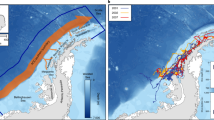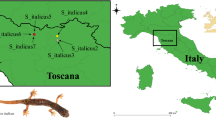Abstract
An ecological model is proposed for human responses to climatic seasonality in the later Holocene of the southwestern Cape in South Africa. This is an area where pronounced seasonality produces cyclical effects on plant, animal and human communities. The predictions of this model are that: 1. human foragers would switch from plant carbohydrates to seal fat as a winter energy source; 2. capture and butchery of seals would vary with season and seal age; 3. capture and butchery of ungulates would vary seasonally; and 4. seals would be exploited differently from ungulates throughout the year. The model is tested against faunal data from Smitswinkelbaai Cave.
Résumé
On propose un modèle écologique des réactions humaines à la saisonalité climatique pour l'Holocène récent dans le cap sud-ouest, Afrique du Sud. C'est une région où la saisonalité produit des effets cycliques sur les communautés végétale, animale et humaine. Les prédictions de ce modèle sont les suivantes: 1. les cueilleurs humains changeaient des féculents végétaux à la graisse de phoque comme source d'énergie en hiver; 2. la prise et la boucherie de phoques variaient avec les saisons et selon l'âge des phoques; 3. la prise et la boucherie des ongulés variaient de façon saisonnière; et 4. les phoques étaient exploités différemment des ongulés pendant toute l'année. On présente un essai préliminaire du modèle sur les données de la caverne Smitswinkelbaai.
Similar content being viewed by others
References
Anderson, A. E. 1972. Indices of carcass fat in a Colorado mule deer population.Journal of Wildlife Management 36:579–94.
Bear, G. D. 1971. Seasonal trends in fat levels of pronghorns,Antilocapra americana, in Colorado.Journal of Mammalogy 52:583–89.
Bigalke, R. C. 1970. Observations on springbok populations.Zoologica Africana 5:59–70.
Binford, L. R. 1981.Bones: ancient men and modern myths. New York: Academic Press.
Black, M. M., Rapson, W. S., Schwartz, H. M. and Rensburg, N. J. van 1945. South African fish products. Part XIX. The South African seal fishery.Journal of the Society of Chemical Industries, London 64:326–31.
Bryden, M. M. 1964. Insulative capacity of the subcutaneous fat of the southern elephant seal.Nature 203:1299–1300.
Bryden, M. M. 1969. Relative growth of the major body components of the southern elephant seal,Mirounga leonina (L.).Australian Journal of Zoology 17:153–77.
Bryden, M. M. and Stokes, G. B. 1969. Metabolism of fatty acids in the southern elephant sealMirouga leonina (L.).Canadian Journal of Biochemistry 47:757–60.
Buchanan, W. F., Parkington, J. E., Robey, F. S. and Vogel, J. C. 1984. Shellfish, subsistence and settlement: some western Cape Holocene observations. InFrontiers: Southern African archaeology today (eds M. J. Hall, G. Avery, D. M. Avery, M. Wilson and A. J. B. Humphreys): pp. 121–30. Oxford: British Archaeological Reports.
Bunn, H. T. 1981. Archaeological evidence for meat-eating by Plio-Pleistocene hominids from Koobi Fora and Olduvai Gorge.Nature 291:574–76.
Chevallerie, M. von la, 1972. Meat quality of seven wild ungulate species.South African Journal of Animal Science 2:101–03.
Chevallerie, M. von la, and Van Zyl, J. H. M. 1971. Growth and carcass development of the springbokAntidorcas marsupialis marsupialis (Zimmerman).Agroanimalia 3:115–24.
Crowell, A. L. and Hitchcock, R. T. 1978. Basarwa ambush hunting in Botswana.Botswana Notes and Records 10:37–51.
David, J. H. M. 1978a. Observations on social organization of springbok,Antidorcas marsupialis, in the Bontebok National Park, Swellendam.Zoologica Africana 13:115–22.
David, J. H. M. 1978b. Observations on territorial behavior of springbok,Antidorcas marsupialis, in the Bontebok National Park, Swellendam.Zoologica Africana 13:123–41.
Davis, T. R. A. 1961. Chamber cold acclimatization in man.Journal of Applied Physiology 16:1011–15.
Deacon, H. J. 1972. A review of the post-pleistocene in South Africa.South African Archaeological Society, Goodwin Series 1:26–45.
Deacon, H. J. 1976.Where hunters gatherered. South African Archaeological Society Monograph 1.
Deacon, J. 1984. Later stone age people and their descendents in southern Africa. InSouthern African prehistory and paleoenvironments (ed. R. Klein): pp. 221–328. Rotterdam: Balkema.
Depocas, F. 1960. Calorigenesis from various organ systems in the whole animal.Federation of American Societies for Experimental Biology, Proceedings 19:19–24.
Dunham, K. M. and Murray, M. G. 1982. The fat reserves of impala,Aepyceros melampus.African Journal of Ecology 20:81–87.
Frisancho, A. R. 1979.Human adaptation. St Louis: C. V. Mosby.
Guthrie, H. A. 1979.Nutrition. St Louis: C. V. Mosby.
Hall, K. R. L. 1962. Numerical data, maintenance activities and locomotion of the wild chacma baboon,Papio ursinus.Proceedings of the Zoological Society of London 139:181–220.
Hammel, H. T., Hiles, J. S., Jackson, D. C. and Anderson, H. T. 1963. Thermal and metabolic responses of the Kalahari Bushmen to moderate cold exposure at night.Technical Report: Arctic Aeromedical Lab. 41:44–62.
Hart, J. S. and Fisher, H. D. 1964. The question of adaptation to polar environments in marine mammals.Federation of American Societies for Experimental Biology, Proceedings 23:1207–14.
Hill, K., Hawkes, K., Hurtada, M. and Kaplan, H. 1984. Seasonal variance in the diet of Ache hunter-gatherers in eastern Paraguay.Human Ecology 12:101–36.
Hiroshige, T., Yoshimura, K. and Itoh, S. 1972. Mechanisms involved in thermoregulatory heat production in brown adipose tissue. InAdvances in climatic physiology (eds. S. Itoh, K. Ogata, and H. Yoshimura): pp. 197–218. New York: Springer-Verlag.
Hsieh, A. C. L. and Carlson, L. D. 1957. Role of the thyroid in metabolic response to low temperature.American Journal of Physiology 188:40–44.
Huntley, B. J. 1971. Seasonal variation in the physical condition of mature male blesbok and kudu.Journal of the South African Wildlife Management Association 1:17–19.
Iampietro, P. T., Bass, D. E. and Buskirk, E. R. 1957. Diurnal oxygen consumption and rectal temperature of men during cold exposure.Journal of Applied Physiology 10:398–400.
Jones, R. 1980. Hunters in the Australian coastal savannah. InHuman ecology in savannah environments (ed. D. R. Harris): pp. 107–46. New York: Academic Press.
Keene, A. S. 1981. Optimal foraging theory in a nonmarginal environment: A model of prehistoric subsistence strategies in Michigan. InHunter-gatherer foraging strategies (eds. B. Winterhalder and E. A. Smith): pp. 171–93. Chicago: University of Chicago Press.
Klein, R. G. 1972. The late Quaternary mammalian fauna of Nelson Bay Cave.Quaternary Research 2:135–42.
Klein, R. G. 1975. Middle Stone Age mananimal relationships in southern Africa: evidence from Die Kelders and Klasies River Mouth.Science 190:265–67.
Klein, R. G. 1980. Environmental and ecological implications of large mammals from upper pleistocene and holocene sites in southern Africa.Annals of the South African Museum 81:223–83.
Klein, R. G. 1981. Stone age predation on small African bovids.South African Archaeological Bulletin 36:55–65.
Leblanc, J. 1975.Man in the cold. Springfield: C. C. Thomas.
Leblanc, J. and Villemaire, A. 1970. Thyroxine and noradrenaline sensitivity, cold resistance, and brown fat.American Journal of Physiology 218:1742–45.
Ledger, H. P., Sachs, R. and Smith, N. S. 1967. Wildlife and food productionWildlife Review of Animal Production 3:13–37.
Louw, G. N. 1969. Nutritive value of natural grazings in South Africa.Proceedings of the South African Society of Animal Production 8:57–61.
Louw, G. N. 1970. Physiological adaptation as a criterion in planning production from wild ungulates.Proceedings of the South African Society of Animal Production 9:53–56.
Manhire, A. H., Parkington, J. E. and Robey, T. S. 1984. Stone tools and sandveld settlement. InFrontiers: Southern African archaeology today (eds M. J. Hall, G. Avery, D. M. Avery, M. Wilson and A. J. B. Humphreys): pp. 111–20. Oxford: British Archaeological Reports.
Marean, C. W. 1985. The faunal remains from Smitswinkelbaai Cave, Cape Peninsula.South African Archaeological Bulletin 40: 100–02.
McLaren, I. A. 1958.The economics of seals in the Canadian artic. Ottawa: Fisheries Research Board of Canada, Arctic Unit, Circular no. 1.
Milton, K. 1984. Protein and carbohydrate resources of the Maku Indians of northwestern Amazonia.American Anthropologist 86:7–27.
Moran, E. F. 1979.Human Adaptability. North Scituate, Mass.: Duxbury Press.
Nelson, R. A. 1975. Implications of excessive protein. InProceedings, IVth Western Hemisphere Nutrition Congress (eds P. L. White and N. Selvy): pp. 71–76. Acton, Mass.: Publishing Sciences Group.
Parkington, J. 1972. Seasonal mobility in the Later Stone Age.African Studies 31:223–43.
Parkington, J. 1976. Coastal settlement between the mouths of the Berg and Olifants rivers, Cape Province.South African Archaeological Bulletin 31:127–40.
Poggenpoel, C. A. and Robertshaw, P. T. 1981. The excavation of Smitswinkelbaai Cave, Cape peninsula.South African Archaeological Bulletin 36:29–35.
Rand, R. W. 1954. Reproduction in the female Cape fur seal,Arctocephalus pusillus (Schreber).Proceedings of the Zoological Society of London 124:717–40.
Random, A. B. 1965. Kidney and marrow fat as indicators of white-tailed deer condition.Journal of Wildlife Management 29:397–98.
Reidhead, V. A. 1980. The economics of subsistence change. InModeling of prehistoric subsistence economies (eds T. K. Earle and A. K. Christensen): pp. 141–86. New York: Academic Press.
Report of the commission of inquiry into the fishing industry. 1971.The utilization of the fish and other living marine resources of South Africa and South West Africa. Pretoria: Government Printer.
Robertshaw, P. T. 1977. Excavations at Paternoster, south-western Cape.South African Archaeological Bulletin 32:63–73.
Robertshaw, P. T. 1979. Excavations at Duiker Eiland, Vredenburg District, Cape Province.Annals of the Cape Provincial Museums 1:1–23.
Schapera, I. and Farrington, E. 1933.The early Cape Hottentots. Cape Town: Van Riebeeck Soc.
Schulze, B. R. 1972. South Africa. InClimates of Africa: World Survey of Climatology 10:501–86. New York: Elsevier Publishing Company.
Schweitzer, F. R. 1979. Excavations at Die Kelders, Cape Province, South Africa: the Holocene deposits.Annals of the South African Museum 78:101–233.
Shaughnessy, P. D. 1981. The status of seals of South Africa and Namibia. InMammals in the seas, vol. 4. FAO Fisheries Series no. 5:383–410.
Speth, J. 1983.Bison kills and bone counts. Chicago: University of Chicago Press.
Speth, J. and Spielman, K. 1983. Energy source, protein metabolism, and huntergatherer subsistence strategies.Journal of Anthropological Archaeology 2:1–31.
Steward, J. H. 1938.Basin-plateau aboriginal socio-political groups. Smithsonian Institution, Bureau of American Ethnology, Bulletin 120.
Stirling, I. and McEwan, E. H. 1975. The caloric value of whole ringed seals (Phoca hispida) in relation to polar bear (Ursus maritinus) ecology and hunting behvior.Canadian Journal of Zoology 53:1021–27.
Thom, H. B. 1952.The journal of Jan van Riebeeck, volume I 1651–1655. Cape Town: Balkema.
Thompson, D. 1939. The seasonal factor in human culture, illustrated from the life of a contemporary nomadic group.Proceedings of the Prehistoric Society 5:209–21.
Ward, J. S., Bredell, G. A. C. and Wenzell, H. G. 1960. Responses of Bushmen and Europeans on exposure to winter night temperature in the Kalahari.Journal of Applied Physiology 15:667–70.
Wenck, D. A., Baren, M. and Dewan, S. D. 1981.Nutrition. Virginia. Reston Publishing.
Wilmsen, E. 1978. Seasonal effects of dietary intake on Kalahari San.Federation of American Societies for Experimental Biology, Proceedings 37:65–72.
Wyndham, C. H. and Morrison, J. F. 1958. Adjustments to cold of Bushmen in the Kalahari desert.Journal of Applied Physiology 13:219–25.
Rights and permissions
About this article
Cite this article
Marean, C.W. Seasonality and seal exploitation in the southwestern Cape, South Africa. Afr Archaeol Rev 4, 135–149 (1986). https://doi.org/10.1007/BF01117038
Issue Date:
DOI: https://doi.org/10.1007/BF01117038




